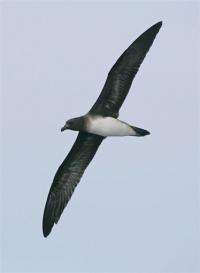A petrel photographed off the north-east coast of Papua New Guinea, in August 2007. The first ever positive identification at sea of one of the world's most mysterious and endangered seabirds has raised hopes for the survival of the Fijian petrel, conservationists have said.
The first ever positive identification at sea of one of the world's most mysterious and endangered seabirds has raised hopes for the survival of the Fijian petrel, conservationists said Monday.
After one specimen was identified in 1855, the Fiji petrel virtually disappeared and was not positively identified again for 130 years.
A successful 11-day expedition by scientists to the seas off the Fijian island of Gau in May was the first time the chocolate coloured petrel had ever been positively identified on the water.
The sighting was made public last week when an expedition organised by Fijian conservation organisation NatureFiji-MareqetiViti announced the find in the latest issue of Bulletin of the British Ornithologists' Club.
Now there are hopes that renewed efforts to find the petrel's nesting burrows believed to be on Gau island can lead to protection measures to ensure the survival of the critically endangered species.
"We really can't get ahead with conserving this bird until we find nesting burrows," Dick Watling of NatureFiji-MareqetiViti told AFP.
"Only when we find those burrows can we protect them and then be assured we've got a population that is recruiting young," he said.
Watling was the first to rediscover the seabird on land at Gau in 1984, using a spotlight at night to attract one of the elusive petrels.
Since then there have been around 16 mainly unconfirmed sightings on Gau, due in many cases to the birds crashlanding on house roofs at night.
The organisation believes probably only about 50 Fiji petrels survive, adding urgency to attempts to find the nesting burrows in forested rugged hills on Gau, which lies about 90 kilometres (56 miles) east of Fiji's main island of Viti Levu.
Watling said new international funding will allow another sea trip in October in the hopes of capturing a petrel and fitting it with a transmitter to hopefully lead scientists to nesting sites.
The funding will also allow specially trained dogs to be brought from New Zealand next year to try to find the nest burrows.
Watling said it was not clear what caused the birds to become so endangered, except their burrows are vulnerable to rats, and feral cats and pigs.
"Petrels are very smelly, humans can smell them, so cats and pigs would be able to smell them a mile off," he said.
"They're still very much an enigma. In the 25 years since rediscovery we've spent a long time searching for the petrel burrows up in the mountains in the forests on Gau without any success."
The success of the May expedition was due to using an extremely odorous and oily concoction of fish offal, which was frozen into blocks and dropped in the sea to attract seabirds.
On the second day, the first Fiji petrel appeared and up to eight individual Fiji Petrels were seen over 11 days in an area around 25 nautical miles south of Gau.
(c) 2009 AFP



















